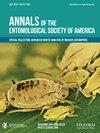Changes in Functional and Numerical Responses of the Parasitoid Wasp Trichogramma brassicae (Hymenoptera: Trichogrammatidae) Over 45 Generations of Rearing on Ephestia kuehniella
IF 1.8
3区 农林科学
Q1 ENTOMOLOGY
引用次数: 2
Abstract
Abstract We assessed the functional and numerical responses of Trichogramma brassicae Bezdenko under long-term rearing (45 generations, G5-G45) on eggs of a common factitious host, Ephestia kuehniella Zeller (Lepidoptera: Pyralidae). Under such long-term mass rearing, the function response of this parasitoid shifted from Type III (from G5 to G20) toType II (from G25 to G45).The maximum attack rate (T/Th) (33.62 hosts/day) and the shortest handling time (0.7138 ± 0.0272 h) were recorded in G5. Also, G45 had the lowest attack rate (21.67 hosts/day) and longest handling time (1.1076 ± 0.0689 h). The handling time increased gradually over the generations (P reg <0.01, R2 = 0.903). The number of eggs laid by the parasitoid increased significantly with increased host density, but reached a plateau at very high densities. While no significant differences in daily parasitism were observed over 45 generations at densities of 2, 4, 8, and 16 available host eggs per wasp, there were significant differences in parasitism at host densities of 32, 64, and 128 eggs per wasp. T. brassicae females were more active and foraged more frequently in earlier generations (G5 to G20), which allowed wasps to parasitize more E. kuehniella eggs compared to later generations. Also, continuous mass rearing of T. brassicae negatively affected foraging behavior and the quality of wasps after G20. However, rejuvenation of the colony by adding field-collected parasitoids or rearing wasps on more suitable factitious hosts is strongly recommended to lower the negative effects of long-term mass rearing on quality of this parasitoid.芸苔赤眼蜂(膜翅目:赤眼蜂科)饲养45代后功能及数值响应的变化
摘要研究了长期饲养(45代,G5-G45)的芸赤眼蜂(Trichogramma brassicae Bezdenko)对kuehniella Zeller(鳞翅目:Pyralidae)寄主卵的功能和数值反应。在这种长期的大量饲养下,该寄生蜂的功能响应从III型(从G5到G20)转变为II型(从G25到G45)。G5的攻击速率最大(T/Th)为33.62台/天,处理时间最短(0.7138±0.0272 h)。G45的攻击率最低(21.67台/d),处理时间最长(1.1076±0.0689 h),处理时间随世代逐渐增加(P <0.01, R2 = 0.903)。随着寄主密度的增加,产卵量显著增加,但在高密度时达到平稳期。在每只寄生蜂2、4、8和16个有效寄主卵密度下,45代寄生蜂的日寄生率差异不显著,而在每只寄生蜂32、64和128个有效寄主卵密度下,寄生蜂的日寄生率差异显著。早代(G5 ~ 20代)的芸苔科雌蜂更活跃,觅食频率也更高,这使得与后代相比,芸苔科雌蜂能够寄生更多的库氏伊蚊卵。二十国集团后,持续大量饲养芸苔蚧对胡蜂的觅食行为和品质产生负面影响。但是,强烈建议通过添加田间采集的寄生蜂或在更合适的人工寄主上饲养寄生蜂来恢复种群,以降低长期大量饲养对寄生蜂质量的负面影响。
本文章由计算机程序翻译,如有差异,请以英文原文为准。
求助全文
约1分钟内获得全文
求助全文
来源期刊
CiteScore
4.90
自引率
0.00%
发文量
25
审稿时长
6-12 weeks
期刊介绍:
The Annals of the Entomological Society of America exists to stimulate interdisciplinary dialogue across the entomological disciplines and to advance cooperative interaction among diverse groups of entomologists. It seeks to attract and publish cutting-edge research, reviews, collections of articles on a common topic of broad interest, and discussion of topics with national or international importance. We especially welcome articles covering developing areas of research, controversial issues or debate, and topics of importance to society. Manuscripts that are primarily reports of new species, methodology, pest management, or the biology of single species generally will be referred to other journals of the ESA. The most important criteria for acceptance are quality of work and breadth of interest to the readership.

 求助内容:
求助内容: 应助结果提醒方式:
应助结果提醒方式:


